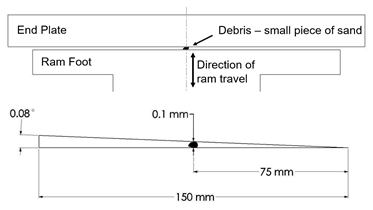Pockets in my mold end plates? Why would I need that? And, what are they, anyways?
Why are pockets important?
The ram heads [ram foot on a Pine gyro] shall stay perpendicular to their axis (AASHTO T312 Section 4.3). The surface of the ram foot shall be perpendicular to the direction in which the ram moves.
The platen side of each end plate [the side of an end plate facing away from the asphalt] shall be flat and parallel to its face [the side of an end plate facing the asphalt] (AASHTO T312 Section 4.3). The face of an end plate is to be parallel with the side of the end plate the interfaces with the ram foot. Because the ram foot surface is perpendicular with the direction in which the ram moves, the face of the end plate is also to be perpendicular with the direction in which the ram moves.
Pine recommends lubricating the ram foot/end plate interface (as well as the end plate/base interface on the 125X and the end plate/gyratory head interface on the GB1). Applying too much lubricant may push the plate away from ram foot surface at an angle. Thus the face of the plate would no longer be parallel with the ram foot. This results in a loss of internal angle of gyration during compaction of a specimen.
Also, asphalt is messy. Small pieces of debris are easy to miss when cleaning an end plate and a ram foot. A small piece of debris caught between an end plate and a ram foot during compaction causes the face of the end plate to no longer be parallel with the surface of the ram foot (Figure 1). The leads to a loss of internal angle during the compaction of a specimen.

Figure 1: Debris Between the End Plate and the Ram Foot.
Finally, the ram foot may develop a crown with use (Figure 2). An end plate without a “pocket” will pivot on the crown during compaction causing a loss of internal angle of gyration.

Figure 2: A Crowned Ram Foot.
A lower internal angle of gyration leads to less compactive effort being applied to the asphalt. Less compactive effort applied to the asphalt results in a specimen of lower density. Low specimen density may be a problem for the contractor and the producer.
What are end plate pockets?
End plates “pockets” are a cut out in the surface of an end plate that faces the ram foot (Figure 3). The void provides space for excess lubricant and small debris to accumulate during the compaction of a specimen. It also reduces the effect of a crowned ram foot by providing space for the point of the crown.
Figure 3: And End Plate with a Pocket
Figure 4 shows the bottom face of a base plate used in the mold assemblies for a 125X, a G1, and a G2. The “pocket” is visible in the center of the plate.

Figure 4
Figure 5 exhibits both sides of the top plate for a 125X and the top and bottom plates for a GB1. The “pocket” is visible on the side of the plate that faces away from the asphalt.

Figure 5
What is Pine’s recommendation?
Pine has been machining new end plates with the “pocket” since 2007. Pine recommends replacing end plates that lack “pockets” or having “pockets” machined in end plates that still meet specifications.



